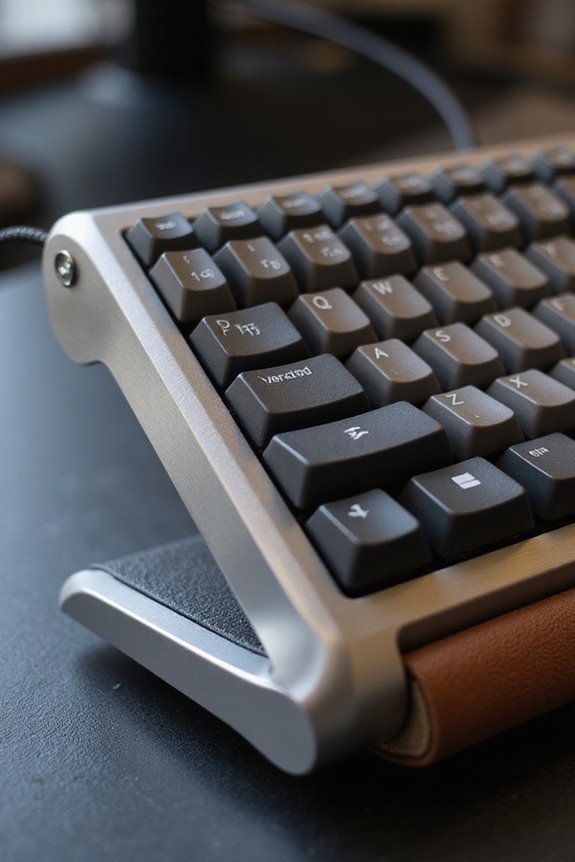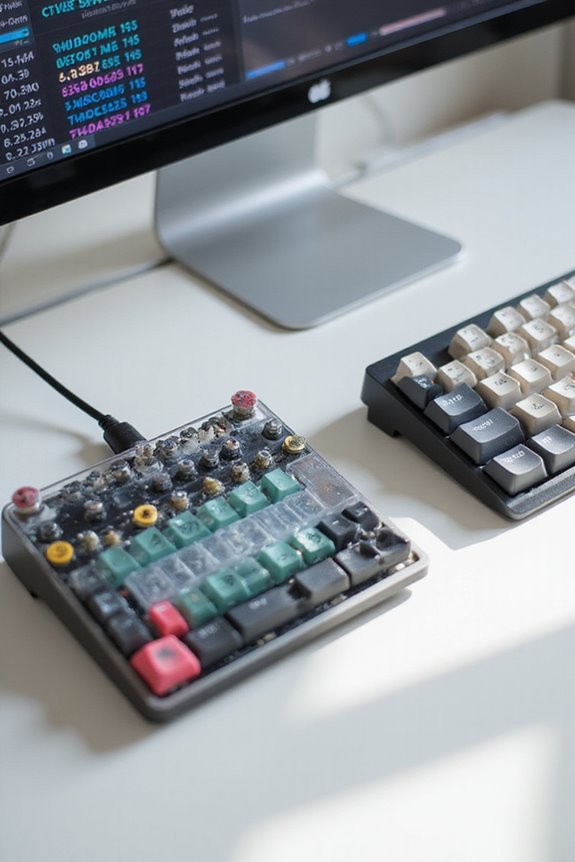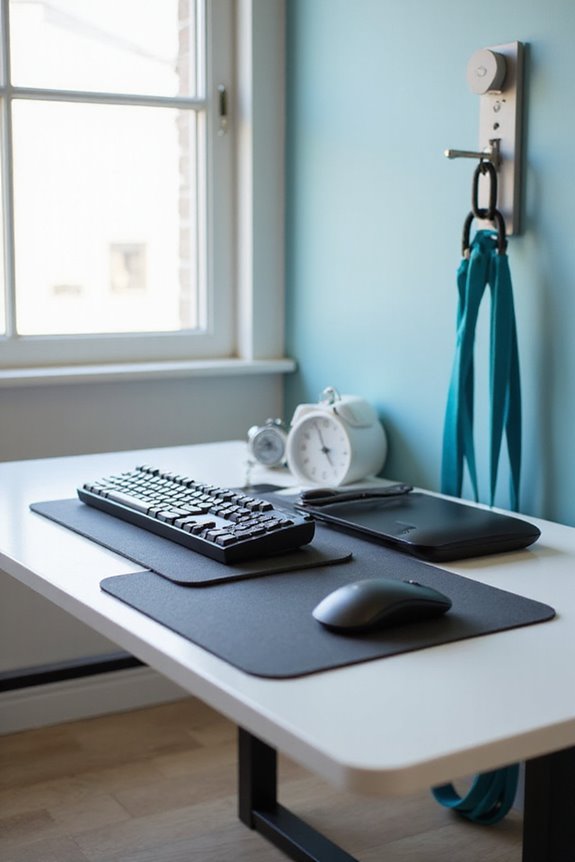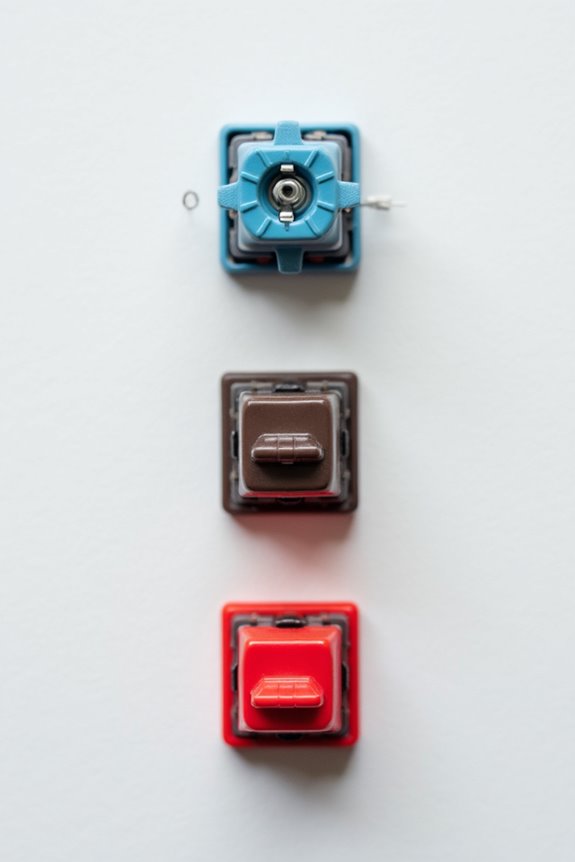An ergonomic keyboard is designed to enhance comfort and reduce strain during typing. It typically features a split design and ergonomic curves, promoting a natural wrist position. Customizable key arrangements minimize finger movement and fatigue. Additionally, many ergonomic keyboards offer wireless connectivity and high-quality materials for durability. With an increased focus on workplace health, ergonomic keyboards can greatly improve comfort during long work sessions. If you’re interested in more details about these features, continue exploring.
Key Takeaways
- Split design promotes a natural wrist position, reducing strain and encouraging better posture during typing.
- Columnar layouts align with finger motions, minimizing movement and fatigue for a more intuitive typing experience.
- Ergonomic curves allow hands to rest in a relaxed state, reducing muscle strain and risk of injuries.
- Customizable key arrangements and hot-swappable switches enhance user comfort and adaptability to individual preferences.
- Durable materials and protective coatings extend keyboard lifespan while improving typing comfort and reducing grime buildup.
Split Design and Ergonomic Curves
When exploring ergonomic keyboards, one of the standout features is their split design, which greatly enhances comfort and reduces strain. The split benefits are significant; they allow for a more natural wrist position, thereby minimizing ulnar deviation. This design promotes better posture by keeping wrists straight and aligned with forearms. Additionally, ergonomic curves guarantee that hands rest in a relaxed state, further reducing muscle strain and the risk of repetitive strain injuries.
The combination of split design and ergonomic advantages not only improves typing efficiency but also helps maintain long-term health for frequent users. By accommodating a more open chest and better elbow placement, these keyboards create an ideal workspace, encouraging focus and reducing clutter.
Key Arrangements and Customizability

Ergonomic keyboards offer various key arrangements that can notably enhance typing comfort and efficiency. One key aspect is key positioning, which minimizes finger movement and reduces fatigue. For instance, columnar layouts and non-staggered designs align with our natural finger motions, making typing more intuitive.
Customization is also essential. Tools like the Ergogen generator utilize layout algorithms to create personalized keyboard setups based on individual preferences. This means you can adjust standard layouts, like QWERTY, to better suit your needs. Additionally, symmetric layouts promote balanced typing, while split designs allow for staggered keys that further enhance ergonomics. Overall, the ability to customize your keyboard can notably improve your typing experience, leading to increased productivity and comfort. Furthermore, mechanical keyboards often provide hot-swappable features that enable users to easily change switches to suit their typing preferences.
Compatibility and Integration

Choosing an ergonomic keyboard involves not just comfort and design, but also how well it works with your devices. Many ergonomic keyboards offer wireless connectivity options, such as Bluetooth, allowing seamless device pairing with desktops, laptops, and even mobile devices. This flexibility guarantees that you can switch between devices effortlessly.
It’s important to note that while some keyboards support multiple device pairings, others may have limitations on how many can be connected simultaneously. Additionally, USB connectivity options provide a stable alternative for those who prefer a wired setup. Overall, selecting a keyboard that integrates well with your existing devices enhances your productivity and user experience, making compatibility a vital factor in your decision-making process.
Materials and Durability

Selecting an ergonomic keyboard involves not only comfort but also the materials that contribute to its overall durability and longevity. The choice of keycap materials is essential; soft yet durable options enhance typing comfort while resisting wear over time. Sturdy frame materials, such as ABS plastic or aluminum, guarantee robust construction, addressing durability concerns. Some keyboards, like the Microsoft Ergonomic Keyboard, may absorb oils, affecting their longevity. To combat this, many keycaps feature protective UV coatings that prevent grime buildup. Additionally, ergonomic designs with sculpted keycaps reduce strain, enhancing the typing experience. By opting for high-quality materials and proper maintenance, you can greatly extend the lifespan of your ergonomic keyboard, making it a worthwhile investment.
User Adoption and Impact

As awareness of workplace health concerns continues to grow, many individuals are realizing the importance of ergonomic keyboards in preventing musculoskeletal disorders. User trends indicate a significant shift towards these keyboards, especially in remote work settings where prolonged computer usage is common. The productivity benefits are significant; ergonomic designs reduce fatigue and enhance comfort, allowing for longer, more efficient work sessions. Features like customizable keys add to their appeal, catering to various user needs. Organizations are increasingly investing in ergonomic solutions to improve employee morale and reduce sick days. With emerging economies in Asia-Pacific also showing interest, the demand for ergonomic keyboards is poised for substantial growth, promising a healthier and more productive work environment. Additionally, mechanical switches are becoming a popular choice in ergonomic keyboards for their high responsiveness and longevity.
Frequently Asked Questions
How Do Ergonomic Keyboards Compare to Traditional Keyboards in Price?
I’ve found that ergonomic keyboards usually come with a higher price tag compared to traditional ones. However, budget options exist, making it easier to achieve comfort without breaking the bank. Price comparison often reveals worthwhile investments!
Can Ergonomic Keyboards Help With Existing Wrist Pain?
I’ve found that ergonomic design greatly alleviates my wrist pain. The thoughtful features encourage better positioning, reducing strain. If you’re struggling, trying one might just be the relief you need.
What Is the Average Lifespan of an Ergonomic Keyboard?
I’ve found that the average lifetime expectancy of an ergonomic keyboard ranges from 5 to 15 years. This often depends on keyboard durability, maintenance habits, and whether it’s mechanical or rubber dome switches.
Are There Specific Ergonomic Keyboards for Gaming?
When it comes to gaming comfort, I’ve found specific ergonomic keyboards designed with a thoughtful keyboard layout that minimizes strain. They enhance my gameplay experience, ensuring I stay focused and comfortable during long sessions.
How Do I Clean and Maintain an Ergonomic Keyboard?
When I clean my ergonomic keyboard, I use effective cleaning techniques like isopropyl alcohol and compressed air. Regular maintenance tips, like inspecting for wear and keeping connections tight, help guarantee it stays in great shape.





